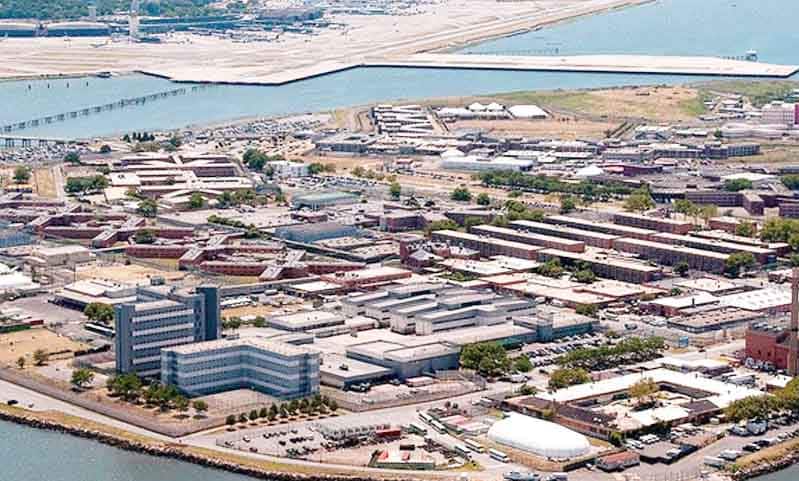All Democrats in the New York City delegation to Congress recently asked President Biden to stop a “humanitarian crisis” on Rikers Island, which they claim Mayor DeBlasio is not adequately addressing.
The detention center is already under federal supervision. That monitor recently told a court that Corrections Department officials should complete “basic correction 101” after a Rikers Island inmate tried to hang himself in his cell.
The congressional letter to Biden cited this incident and several others. “It should go without saying that these conditions are unacceptable,” wrote Bronx Rep. Ritchie Torres.
“We cannot continue to allow Rikers Island to deteriorate to the point that it is no longer a safe place for those in custody or those who work in the jails.
We are neglecting to meet our responsibility to care for incarcerated New Yorkers with dignity and respect,” he added. Torres and the other representatives who signed the letter are especially concerned because DeBlasio has reopened parts of Rikers Island, a facility he promised to close.
Property Owner Responsibility
First things first. In terms of legal duty, most detention inmates are invitees. The owner, which in the Rikers Island situation is the city, benefits economically.
The state reimburses the city on a per-inmate basis. There is a noneconomic benefit as well. Violent criminals are not on the street.
Largely because of this dual benefit, the city has a duty of reasonable care to maintain high health and safety standards.
Furthermore, according to the Supreme Court, officials cannot show deliberate indifference to health and safety issues. Deliberate indifference is a rather vague phrase that courts are still interpreting. However, it’s clear that there is a health and safety line that cannot be crossed.
Typically, the injury-causing incident is a fall, infectious disease, like COVID-19, or something else directly related to property condition or the owner’s management.
Sometimes, however, a third party causes injury, usually in a fight. Compensation could be available if the detention center had a legal duty, the injury was foreseeable, and the owner knew about the safety hazard.
Evidence of foreseeability includes:
- Character and nature of the property,
- The area’s reputation as a “high crime” area,
- Prior similar incidents at that location, and
- Prior similar incidents in the area.
All these factors are apparent at detention centers like Rikers Island. For example, these places are the very definition of “high crime” areas.
Furthermore, due to the nature of the property, violent people with short tempers are housed there regularly. Making matters worse, many Rikers Island inmates may have substance abuse problems, and could be in withdrawal.
Establishing Negligence
Basically, negligence is a lack of care. To obtain compensation, the property owner’s behavior must have been so bad that it fell below the acceptable standard of care.
Establishing knowledge of the defect is the first step in establishing negligence. As mentioned, the defect is usually a hazard inherent to the property, like an uneven walkway, or a violent inmate.
Proof on this point can be direct or circumstantial.
Direct evidence includes things like restroom cleaning reports or safety audits. Indirect knowledge includes things like putting members of rival gangs in the same day room.
Either way, the victim must establish knowledge by a preponderance of the evidence (more likely than not).
Additionally, the proof must be strong enough to overcome some common defenses. Assumption of the risk may be the most common one, especially in detention center injury claims. Property owners are not responsible for damages if the victim voluntarily assumed a known risk.
Jails and detention centers are full of risks. Everyone knows that. They are usually not clean and there are usually some very bad people in these facilities. However, almost no one voluntarily goes to jail.
Injury Claims Against Government Officials
A very old doctrine, sovereign immunity, made it impossible to sue the city, county, state, or federal government following a serious injury incident.
However, New York has expressly waived its sovereign immunity in most injury cases. Now, compensation is available if a government employee was negligent, and the victim files a notice of claim.
We talked about negligence above. Now, let’s talk about the notice of claim. This notice is basically the last remaining bit of sovereign immunity. It gives New York City and other government entities a chance to settle claims quietly before they go to court.
Furthermore, very strict time deadlines apply. Generally, victims have only ninety days from the time of injury to file a notice of claim.
Courts occasionally grant extensions, but it’s best not to count on one. So, if you or a loved one was hurt at Rikers Island or in another government-involved incident, like a motor vehicle crash, you have an extremely limited amount of time to act.
Injured Rikers Island inmates deserve compensation. For a free consultation with an experienced personal injury attorney in New York, contact Napoli Shkolnik PLLC.
